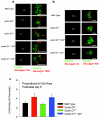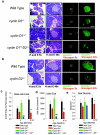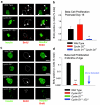Cyclins D2 and D1 are essential for postnatal pancreatic beta-cell growth
- PMID: 15831479
- PMCID: PMC1084308
- DOI: 10.1128/MCB.25.9.3752-3762.2005
Cyclins D2 and D1 are essential for postnatal pancreatic beta-cell growth
Abstract
Regulation of adult beta-cell mass in pancreatic islets is essential to preserve sufficient insulin secretion in order to appropriately regulate glucose homeostasis. In many tissues mitogens influence development by stimulating D-type cyclins (D1, D2, or D3) and activating cyclin-dependent kinases (CDK4 or CDK6), which results in progression through the G(1) phase of the cell cycle. Here we show that cyclins D2 and D1 are essential for normal postnatal islet growth. In adult murine islets basal cyclin D2 mRNA expression was easily detected, while cyclin D1 was expressed at lower levels and cyclin D3 was nearly undetectable. Prenatal islet development occurred normally in cyclin D2(-/-) or cyclin D1(+/-) D2(-/-) mice. However, beta-cell proliferation, adult mass, and glucose tolerance were decreased in adult cyclin D2(-/-) mice, causing glucose intolerance that progressed to diabetes by 12 months of age. Although cyclin D1(+/-) mice never developed diabetes, life-threatening diabetes developed in 3-month-old cyclin D1(-/+) D2(-/-) mice as beta-cell mass decreased after birth. Thus, cyclins D2 and D1 were essential for beta-cell expansion in adult mice. Strategies to tightly regulate D-type cyclin activity in beta cells could prevent or cure diabetes.
Figures







References
-
- Bell, G. I., and K. S. Polonsky. 2001. Diabetes mellitus and genetically programmed defects in beta-cell function. Nature 414:788-791. - PubMed
-
- Bonner-Weir, S. 2001. Beta-cell turnover: its assessment and implications. Diabetes 50(Suppl. 1):S20-S24. - PubMed
-
- Bonner-Weir, S., E. Toschi, A. Inada, P. Reitz, S. Y. Fonseca, T. Aye, and A. Sharma. 2004. The pancreatic ductal epithelium serves as a potential pool of progenitor cells. Pediatr. Diabetes 5(Suppl. 2):16-22. - PubMed
-
- Butler, A. E., J. Janson, S. Bonner-Weir, R. Ritzel, R. A. Rizza, and P. C. Butler. 2003. Beta-cell deficit and increased beta-cell apoptosis in humans with type 2 diabetes. Diabetes 52:102-110. - PubMed
Publication types
MeSH terms
Substances
Grants and funding
LinkOut - more resources
Full Text Sources
Other Literature Sources
Medical
Molecular Biology Databases
Research Materials
